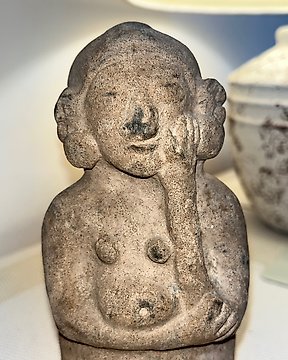
图马科-托利塔 Terracotta 孕妇的思考位置 - 23 cm
编号 83212099

编号 83212099

Representation of the god of corn, in which they warn a Cinerary urn front
Zapoteca, Mexico.
300-500 AD.
Terracotta
17.5 cm Height
PROVENANCE: Smaller Bay Mask - Cano Gallery, Quito, Ecuador, November 7, 1980. Romy Rey Collection, London.
CONDITION: Good Condition.
DESCRIPTION:
The Zapotec culture arose in the Central Valleys of what is now the State of Oaxaca, Mexico, 500 BC – 150 AD. Oaxaca is a predominantly mountainous area with a variety of ecosystems that range from high mountain temperate forests to lowland tropical rainforests.
The Zapotecs were mainly an agricultural people. Their sophisticated irrigation system enabled them to produce large quantities of food, with maize as a staple crop. Perhaps their most significant achievement was the development of a writing system, which remained in use for over a thousand years in Mesoamerica. Only certain classes were literate, but Zapotec writings have been found on a wide variety of materials including bone, seashell, ceramic, and stone. It is believed that they also wrote on perishable materials such as wood, cotton textiles, paper, and animal skins. The Zapotec writing system consists of glyphs that describe historic events and dates, and was probably used by the ruling classes to record their deeds and keep accounts of goods and labor. It was also used to tell stories of wars and battles.
The Zapotecs are celebrated for their stoneworking skill, especially the decorative designs that appear often in their architecture. Their bas-reliefs and wall paintings constitute some of the most valuable expressions of pre-Hispanic art in Mexico. Particularly noteworthy are the images of warriors and captives, which reflects the importance of war in Zapotec culture. Also of note are the designs known as “dancers”, which depict individuals in scenes of sacrifice and submission. The architecture of the late Zapotec period features more elaborate decoration of mosaics, carved slabs, and friezes.
The society was highly stratified, with a governing class that probably ruled with a theocratic model. This elite maintained power through a system of alliances and marriages with local authorities in the territory under the group’s influence.
Beneath the nobility were traders and specialized craftsmen, while the large peasant class formed the base of the social pyramid.
Usually, this culture buried their dead nearby, beneath the floor of their dwellings or close by. These were simple burials and did not involve any kind of construction. Some graves, however, do include complex constructions: doorways covered with bas-reliefs, vestibules, burial chambers, and polychrome wall paintings. Highly detailed bas-relief representations of players of the Mesoamerican ball game, which carried great ritual and symbolic significance for the Zapotecs, shared space with images of priests, offerings, and jaguars – an animal that played a central role in all Mesoamerican religions. Sacrifices seem to have played an important role in religious life also, given the large number of bas-reliefs showing people either in their death throes or already sacrificed. The gallery of the “Dancers” at Monte Albán is a example of such artwork.
The earliest Zapotec villages were built on the banks of rivers, in locations suitable for growing maize. Each consisted of about 10 dwellings around which daily activities were carried out. The culture’s main urban center was Monte Albán, strategically located on a terraced mountain plain overlooking the surrounding valley. This center grew rapidly and monumentally to a radius of 4km around the central plaza. It had two courts for playing the Mesoamerican ball game as well as several other imposing structures. Residents’ dwellings were located on the sides of the mountain, away from the central complex. Zapotec homes consisted of a dwelling with a small garden, a well for storing water, and spaces for craft workshops.
Many decorative elements found in the central plaza at Monte Albán show clear influences from the Teotihuacán culture. Mixtec artifacts and offerings also have been found in some buildings, suggesting possible contact and religious links between these two cultures. Around 800 AD, Monte Albán began to decline as the Zapotecs came into increasing contact with the Mayan civilization. Internal strife brought about the collapse of the culture around 1300 AD.
Notes:
The seller guarantees that he acquired this piece according to all national and international laws related to the ownership of cultural property. Provenance statement seen by Catawiki.
The seller will take care that any necessary permits, like an export license will be arranged, he will inform the buyer about the status of it if this takes more than a few days.
The piece includes authenticity certificate.
The piece includes Spanish Export License.